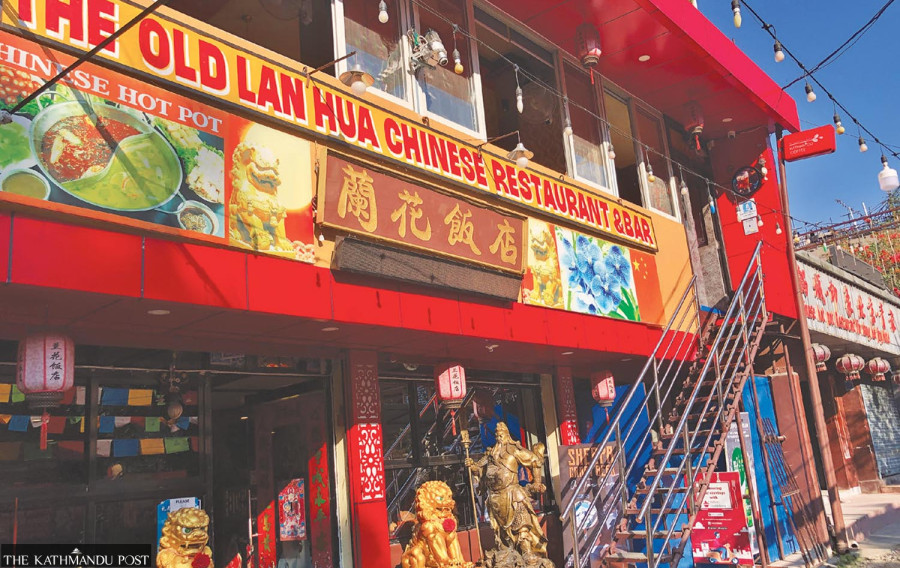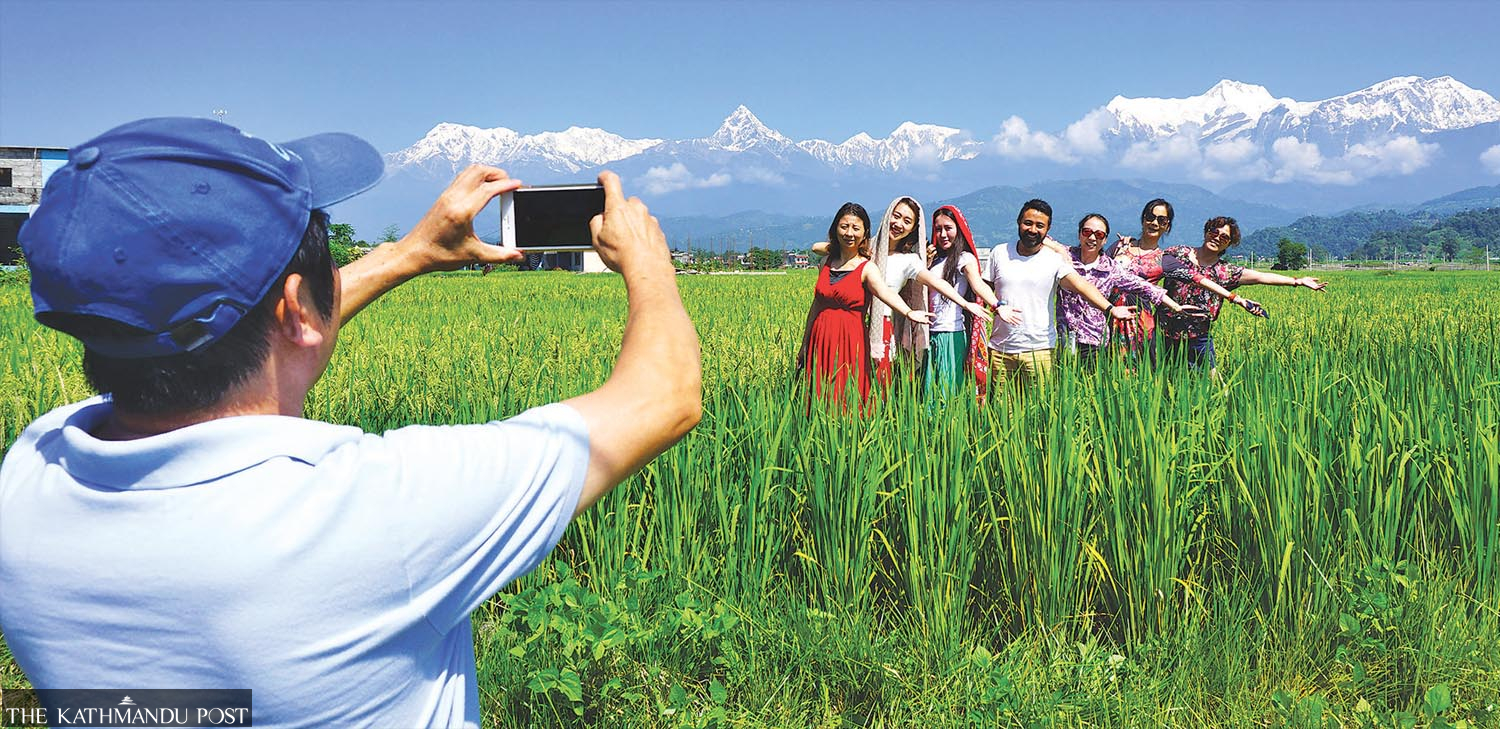Money
Chinese tourist boom turns to bust after Covid
Arrivals expected to rise after Kerung and other Chinese border points open, and Pokhara Airport begins flights.
Sangam Prasain & Deepak Pariyar
In the first quarter of 2018, China overtook long-time record-holder India as the largest sender of tourists to Nepal. Industry sources attributed the surge in Chinese arrivals to a warmer policy towards Nepal after the formation of a left alliance government in Kathmandu.
Chinese arrivals also shot up after flight frequencies between the two countries expanded as more Chinese airlines started adding Kathmandu to their networks.
Five Chinese carriers—Air China, China Southern, China Eastern, Sichuan Airlines and Tibet Airlines—began services to Nepal. Overland connections also improved.
In 2017, the Rasuwagadhi-Kerung border point was upgraded to an international crossing point with the aim of developing it as a major portal linking China to the whole of South Asia. Tourists too started streaming into Nepal through this transit point.
Since January 2016, Nepal has been providing free visas to Chinese tourists, putting them on par with SAARC nationals.
Analysts say Chinese travel interest in Nepal was set off by the release of a Chinese movie ‘Up in the Wind’ in 2013. Shot in the tourist spots of Kathmandu, Pokhara and Chitwan, the film made Nepal popular among Chinese travellers, and arrivals turned into a torrent, particularly to Pokhara in the Annapurna foothills.
Pokhara saw more Chinese visitors than Kathmandu, and many Chinese tourist guidebooks listed the lakeside city as one of the "top ten places in the world to see before you die".
Tourism entrepreneurs literally painted the town red. Gaurighat in Pokhara, decorated with Chinese-themed sign boards and menus, transformed into China Town.
Gaurighat became the first destination for every Chinese visitor. Chinese cuisine started dominating the hotel menus of Pokhara, which once served only Indian and Continental dishes.
Chinese arrivals to Nepal crossed the 100,000 mark for the first time in 2013, largely due to improved air links between the two countries. Around 93 percent of Chinese tourists were first-time visitors to Nepal, according to the Tourism Ministry’s statistics.
In 2014, Nepal received 123,805 Chinese visitors. Thereon, tourist arrivals started rising steadily, and China saw the strongest growth of 46.8 percent, to 153,633 visitors, in 2018.
The boom, alas, turned to bust almost as fast. The Covid-19 pandemic came, and all the Chinese tourists were gone in a flash.
Most Chinese restaurants in Pokhara are now closed, and the advertisements hanging over their doorways have come down.
China Town Restaurant and Bar on Barahi Street does not see a single Chinese diner these days.
The Chinese owner Hou Sen Tian has left the restaurant in the care of its Nepali manager Rishi Raj Acharya. Acharya is waiting for Chinese tourists to come back.
Tian, who is often credited with popularising Chinese cuisine in Pokhara, is planning to sell the restaurant, according to Acharya.
He came to Pokhara with his family from Kolkata, and established Lan Hua Restaurant in 1995. After the restaurant opened, the number of Chinese food enthusiasts grew.
Tian handed over the restaurant to his son in 2007, and set up another establishment China Town at Lakeside. He divorced his wife and married a Nepali.
Currently, Tian’s son looks after Lan Hua Restaurant, now famous by the name Old Lan Hua among Nepali customers. It is now largely dependent on Nepali customers to stay afloat. Another Chinese restaurant near Lan Hua has shut down.
Chinese entrepreneurs had begun setting up shop in Pokhara before Tian arrived.
Ugen came to Nepal in 1988 with a Chinese construction company to build Bhupi Sherchan Highway connecting Baglung and Pokhara. He married Kalpana Thakali, a local of Mustang, and decided to stay in Nepal.
Ugen established Gautam Guest House and Restaurant in Pokhara in 1990, and set the trend of Chinese investment. Kalpana leased out the restaurant to a Nepali after Ugen passed away four years ago.

Khim Nepali of Kaskikot was working as the manager of Machhapuchchhre Guest House when he met a Chinese woman Lu Hai Yan in 2008.
Khim, who was also a trekking guide, took Yan hiking on the Ghorepani-Ghandruk route. They also went on a month-long trip to India where they fell in love, and got married six months later in China. The couple ran a business selling electric appliances.
They decided to set up a hotel and established the Giri Guest House at Gaurighat. Chinese tourists started arriving through contacts of Yan. The couple established Yan Chow Adventure Travel after the hotel prospered.
According to Khim Nepali, Chinese visitors usually spend a week in Pokhara. “Chinese tourists come looking for Chinese restaurants as they don’t speak English, and the employees of many hotels and restaurants in Pokhara don’t understand Chinese. Chinese-speaking guides are scarce too,” said Nepali.
In 2013, the husband-wife team set up a new restaurant, Dau Fan Lai Chinese Restaurant, near their Giri Guest House. They brought a chef from China for a monthly salary of Rs120,000.
“We decided to make more investments seeing the rise in tourist numbers,” said Khim.
But Dau Fan Lai Chinese Restaurant failed after the 2015 earthquake. They sold it to chef Lija and his girlfriend. Lija’s girlfriend succumbed to Covid two years ago, and subsequently he left for India.
The restaurant is now closed, and the landlord has placed an advertisement to rent it out.
Since China opened up to the world in 1978, its citizens have been travelling beyond its borders in ever greater numbers.
In 2013, the number of outbound Chinese travellers hit the top spot globally for the first time. But Covid reversed the trend.
The history of Chinese tourists in Nepal is not long. The northern neighbour gave Nepal the Approved Destination Status (ADS) in 2002; and in June of the same year, Chinese citizens began visiting Nepal officially for the first time as tourists. Nepal is the 18th nation to receive the status and the first in South Asia.
The two countries signed an initial memorandum of understanding on an implementation plan for outbound travel by Chinese people to Nepal on April 16, 2001, laying the groundwork for the ADS.
Nepal first participated in the China International Travel Fair in 2000 to promote its tourism sector. Before 2000, Chinese were allowed to travel to Nepal only on official visits.
Subsequently, the central banks of the two countries signed an agreement on bilateral cooperation that allowed Chinese currency to be converted in Nepal in a bid to boost bilateral trade, tourism and economic cooperation.
Between the founding of the People’s Republic of China in 1949 and 1982, few residents of China had travelled to foreign destinations other than government officials, students and a few businessmen.
In 1983, China allowed citizens from Guangdong province to travel to the British colony of Hong Kong on organised tours to visit family.
Beginning in 1995, the Chinese National Tourism Administration formalised China’s ADS policy. But immediately after Nepal received the ADS, arrivals from China fell due to a violent conflict that intensified over the 2002-04 period, reaching Nepal’s main cities and tourist destinations.
After June 2009, Nepal started witnessing a constant growth in Chinese arrivals.
In Pokhara, a large number of Chinese restaurants opened in Ambot, Barahi Chowk and Centrepoint of Lakeside. Chinese entrepreneurs based in Pokhara even formed an organisation named the Overseas Chinese Association in January 2015.
According to the association, Chinese investors have sunk money in 35 hotels and restaurants in Pokhara. The investments range from Rs3 million to Rs15 million.
Besides hotels and restaurants, they have invested in apartments, departmental stores and agri businesses. Almost all these Chinese ventures have closed down after Covid.
Shang Shao Khwa, general secretary of the association, has been involved in the agriculture business in Pokhara for a decade. He has rented a farm in Rithepani at Pokhara -27.
His biggest customers were the Chinese restaurants in Pokhara; but as there are only a few of them now, he sells his products in the local market.
“Many Chinese left the business after the Covid-19 pandemic as they were not earning enough even to cover the rent. Some sold their businesses at reduced prices,” said Shang.
“Some are still willing to continue their businesses if the Chinese government reopens the border and tourists start coming.”
According to Shang, around 70 percent of the customers in the restaurants were Chinese tourists, 15 percent were Nepalis and the remaining were tourists from other countries.
“The Chinese construction workers at Pokhara International Airport were customers of those restaurants too,” added Shang.
The restaurants obtained most of their requirements like spices and other ingredients from China, but items like vegetable greens, rice, oil, meat and fish were bought locally.
Currently, only three Chinese restaurants are in operation in Lakeside.
Zhan Jiang Song, president of the association, anticipates the number of Chinese visitors to soar as soon as the situation at Kerung and other Chinese border points eases, and Pokhara International Airport comes into operation.
“To attract a larger number of tourists, the Kathmandu-Pokhara and Pokhara-Lumbini highways must be revamped. This place has an enticing climate and friendly people. Tourists from neighbouring countries are keen to come here,” said Zhan.
Chinese business owners have also been accused of making illegal investments. Local traders suspect Chinese investments of not being transparent and convincing.
Lakshman Subedi, chairman of the Hotel Association of Nepal Pokhara Chapter, said Chinese investors had come looking for land to build a five-star hotel in Pokhara before the pandemic. There were even Chinese investors bidding for the Fulbari Hotel.
Kishore Raj Pandey, chairman of Saathi Nepal Travel and Tours, who was the first person to bring Chinese tourists to Nepal in 2001, said China may allow their citizens to travel outside the country from May 2023.
“Internal movement of people has started, but no Chinese currently possess a passport,” said Pandey, who was also the first Nepali to become the general manager of a five-star hotel in 1982.
“China is opening Hong Kong to its citizens in the first stage, and we expect Nepal is also on the priority list.” According to Pandey, millions of Chinese may soon start travelling. “We are hopeful that Chinese tourists will return to Nepal.”




 13.12°C Kathmandu
13.12°C Kathmandu
.jpg)














